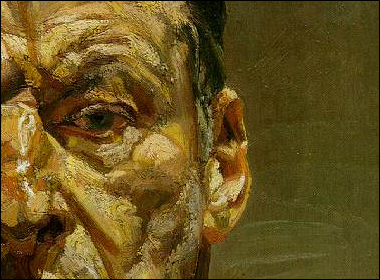I am finding just choosing 3 artists/designers that influence me very hard. There's far too many to choose from! It got me looking at work from Escher, Cindy Sherman, Cosmin Bumbut, Xio Xin, and David Carson to name but a few. It has got me thinking about what areas of design interest me the most and how researching other designers practice is involved in my design process. I have always had a love of portraiture as you can see from my first two artists Lucian Freud, for his beautifully textured expressive paintings. His subjects are often in awkward positions or commencing situations that give his paintings a highly personal viewpoint of the relationships he has with his subjects. My second choice is Sonya Suhariyan who uses traditional tools to create her ideas of the female form that merge the commercial world with fine art. My final choice is Saul Bass for his clear cut, simple use of shape and colour.
Although there are many digital artists that also influence me I find that starting with traditional forms of artwork make my design process more unique so that I can blend the new with the old.
Lucian Freud, painter
I have loved Lucian Freuds work for many years as his work oozes passion and expression with big texturised brush marks. He appeals to me through the intensity that the colours, tones etc create that bring the character to real life. I also like the fact that he doesn't glamourise his subject. When you look at his painting you get a sense of 'real life' and not something commercially fabricated. In terms of influencing my work as a multimedia practitioner I want to take on board and not forget my love of painting. In all of my work I like to bring in some form of traditional media with all the technology driven tools I am using. Also refering back to his work reminds me that pen and paper are always a good starting point whilst designer. It isn't about how many new technologies I use it is about how I use them to compliment eachother.
 Sonya Suchariyan, Illustrator
Sonya Suchariyan, IllustratorAlthough I have only recently discovered this new Russian illustrators work. I like the way she using multi disciplines to illustrate her work. She uses photograhy and various forms of painting and drawing to influence modern music and fashion culture. She appeals to me because of her vivid but careful use of colour, her eye for line and detail and suttle messages she communicates trhough her work. A good thing to remember from looking at her practice in relation to mine is that I can use illustration to add content and diversity to my websites whether it be hand drawn or didgitally done.
Saul Bass is an all round master. He uses simplistic shapes, block colour to grab peoples attention to the message and create classic logo design that introduced a new way of poster design in that era. I think the piece below works well because the simplistic shapes let you know quickly and effectively what the film is about. By doing this is attracts more people as he doesn't over complicate his design so people are put off. He brought movie credits out of the darkness and brought it into being an integral part of the movie. This is a value that I want to take on board to bring my website design together. Some websites I design I will have to incorporate a lot of information that people will have to browse though but I intend to use graphics, illustrations, films and all round good design to absorb peoples attention.




































.png)
.png)
.png)









